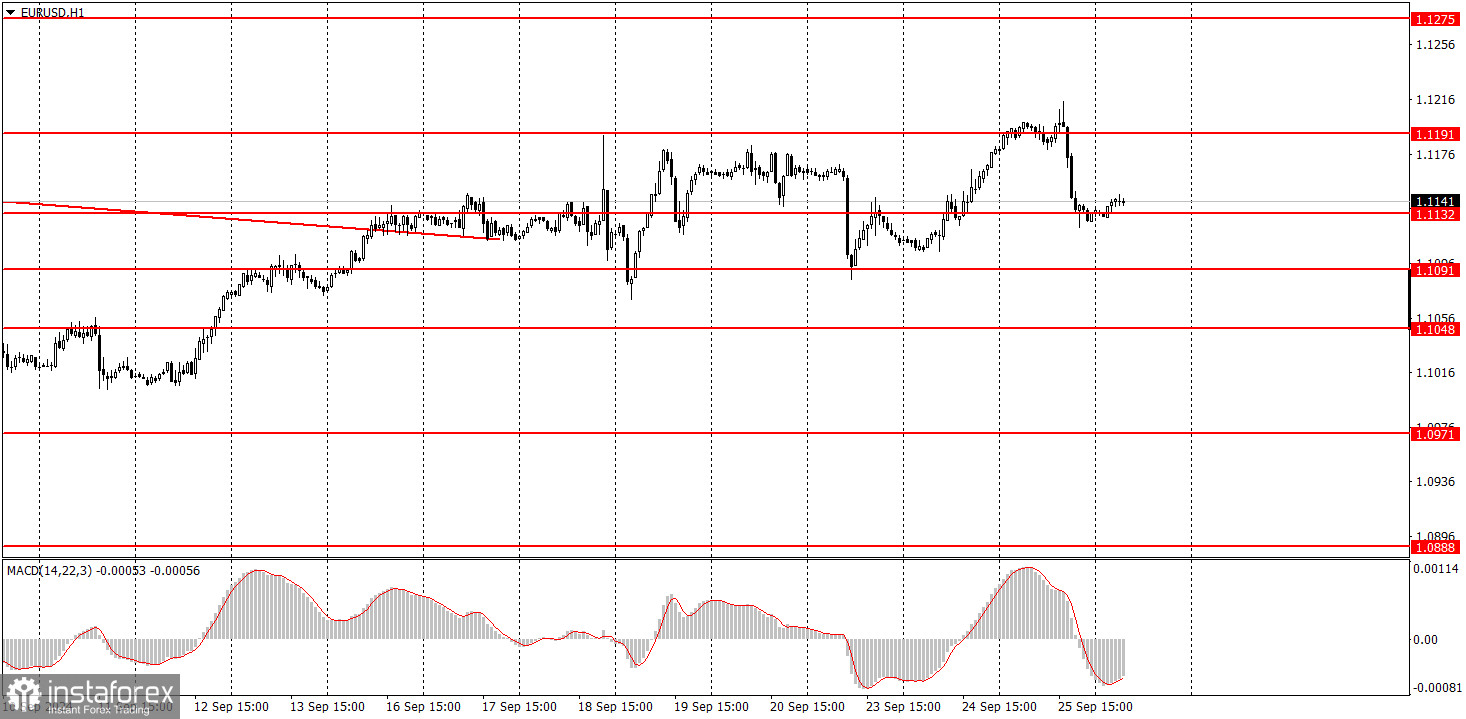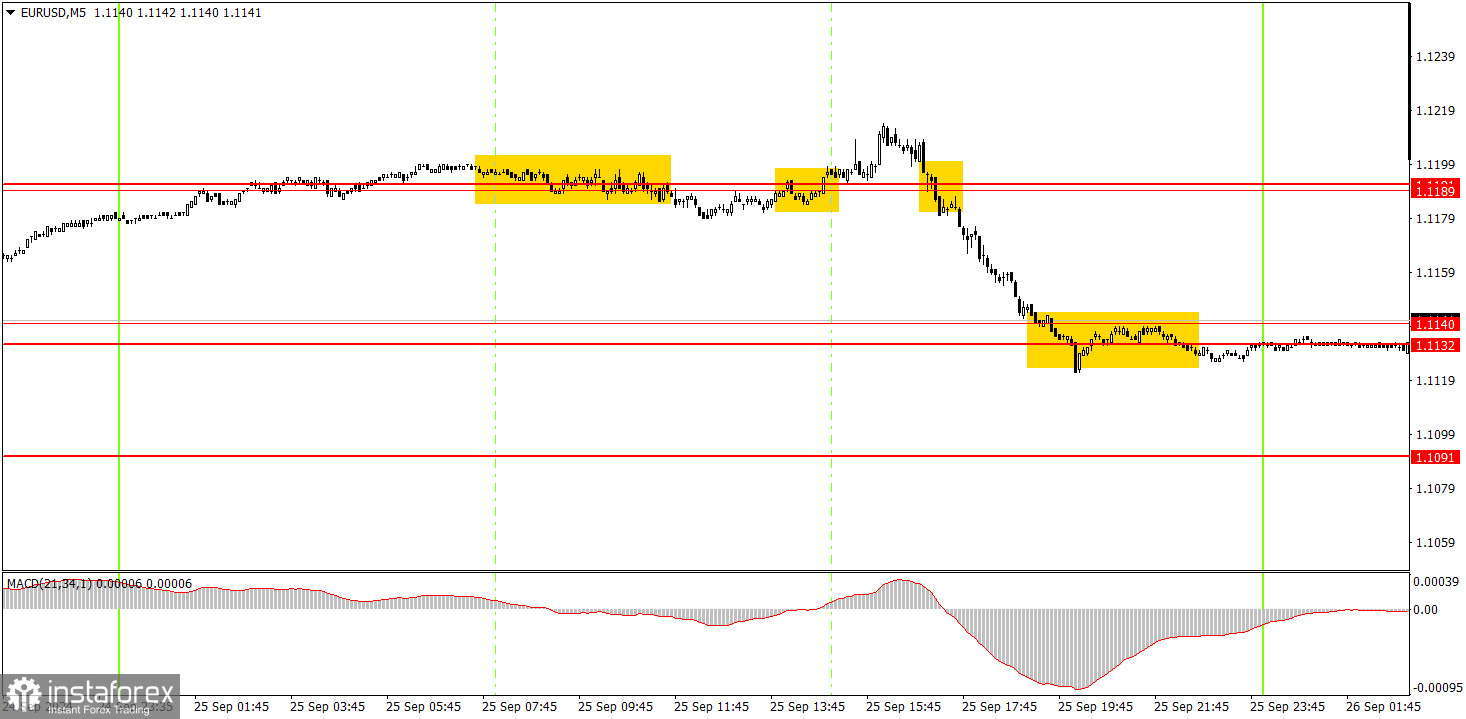Analysis of Wednesday's Trades:
EUR/USD on 1H Chart

The EUR/USD pair experienced a significant decline on Wednesday. This drop wasn't linked to macroeconomic or fundamental events; the economic calendar was nearly empty yesterday. One could mention the report on new home sales in the US, released later in the evening, by which time the price had already finished its decline. However, it's clear to any trader that the euro underwent a minor downward correction. Therefore, the upward trend is still intact, but in recent days and weeks, the price has been moving upward very slowly. The market is already finding it difficult to push the pair upward since all possible buying factors have been repeated several times. As such, there are simply no grounds for further new growth. We still consider any rise from the current positions to be illogical and expect the beginning of a new medium-term downward trend.
EUR/USD on 5M Chart

Several signals were formed in the 5-minute time frame on Wednesday. The main movement began during the US trading session, while during the European session, the price remained stagnant, ignoring the rather important area of 1.1189-1.1191. Therefore, positions could only be opened during the US session, but predicting a sharp decline would start then was impossible. Overall, we observed a very good movement, but it was highly challenging to capitalize on it.
How to Trade on Thursday:
In the hourly time frame, the EUR/USD pair still has a chance to form a downward trend, but these chances are fading quickly. Unfortunately, the irrational selling of the dollar can easily continue in the medium term, as no one knows how much longer the market will react to the Federal Reserve's monetary easing while ignoring the European Central Bank's easing policies. However, over the past couple of weeks, it has become clear that market participants are finding it difficult to push the pair further upwards. We may be approaching the end of the upward trend, but important data from the US are expected next week.
The pair could quickly recover from Wednesday's losses on Thursday. As noted, no reasons are necessary for the dollar to fall. Today, fundamental and macroeconomic factors will be important, so movement in either direction can be expected.
In the 5-minute time frame, consider the levels 1.0726-1.0733, 1.0797-1.0804, 1.0838-1.0856, 1.0888-1.0896, 1.0940, 1.0971, 1.1011, 1.1048, 1.1091, 1.1132-1.1140, 1.1189-1.1191, and 1.1275-1.1292. On Thursday, ECB President Christine Lagarde will give a speech in the Eurozone, and Fed Chairman Jerome Powell will give a speech in the US. In addition, reports on Q2 GDP and durable goods orders will be published in the US.
Basic Rules of the Trading System:
1) Signal Strength: The strength of a signal is determined by the time it takes to form (bounce or break through a level). The less time it takes, the stronger the signal.
2) False Signals: If two or more trades are opened near a certain level based on false signals, all subsequent signals from that level should be ignored.
3) Flat Market: In a flat market, any pair can generate numerous false signals or none at all. In any case, it's better to stop trading at the first signs of a flat market.
4) Trading Timeframe: Trades should be opened between the start of the European session and the middle of the American session, after which they should be closed manually.
5) MACD Indicator Signals: In the hourly time frame, it is preferable to trade based on MACD signals only when there is good volatility and a trend confirmed by a trendline or trend channel.
6) Close Levels: If two levels are located too close to each other (between 5 and 20 pips), they should be considered as a single support or resistance area.
7) Stop Loss: Once the price moves 15 pips in the intended direction, a Stop Loss should be set at the breakeven point.
What's on the Charts:
Support and Resistance Price Levels: These levels serve as targets when opening buy or sell positions. They can also be used as points to set Take Profit levels.
Red Lines: These represent channels or trend lines that display the current trend and indicate the preferred trading direction.
MACD Indicator (14,22,3): The histogram and signal line serve as an auxiliary indicator that can also be used as a source of trading signals.
Important Speeches and Reports (always found in the news calendar) can significantly impact the movement of a currency pair. Therefore, trading should be done with maximum caution during their release, or you may choose to exit the market to avoid a sharp price reversal against the preceding movement.
For Beginners Trading on the Forex Market: It's essential to remember that not every trade will be profitable. Developing a clear strategy and practicing money management is key to achieving long-term success in trading.





















